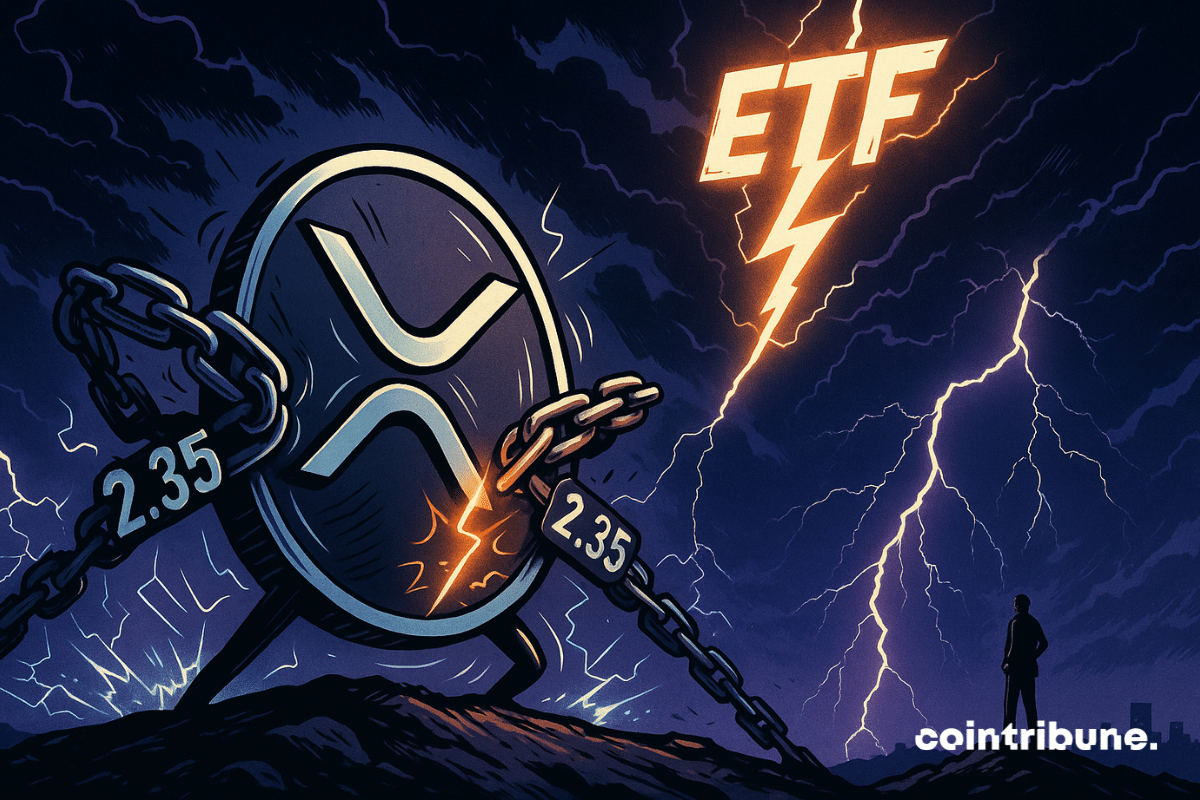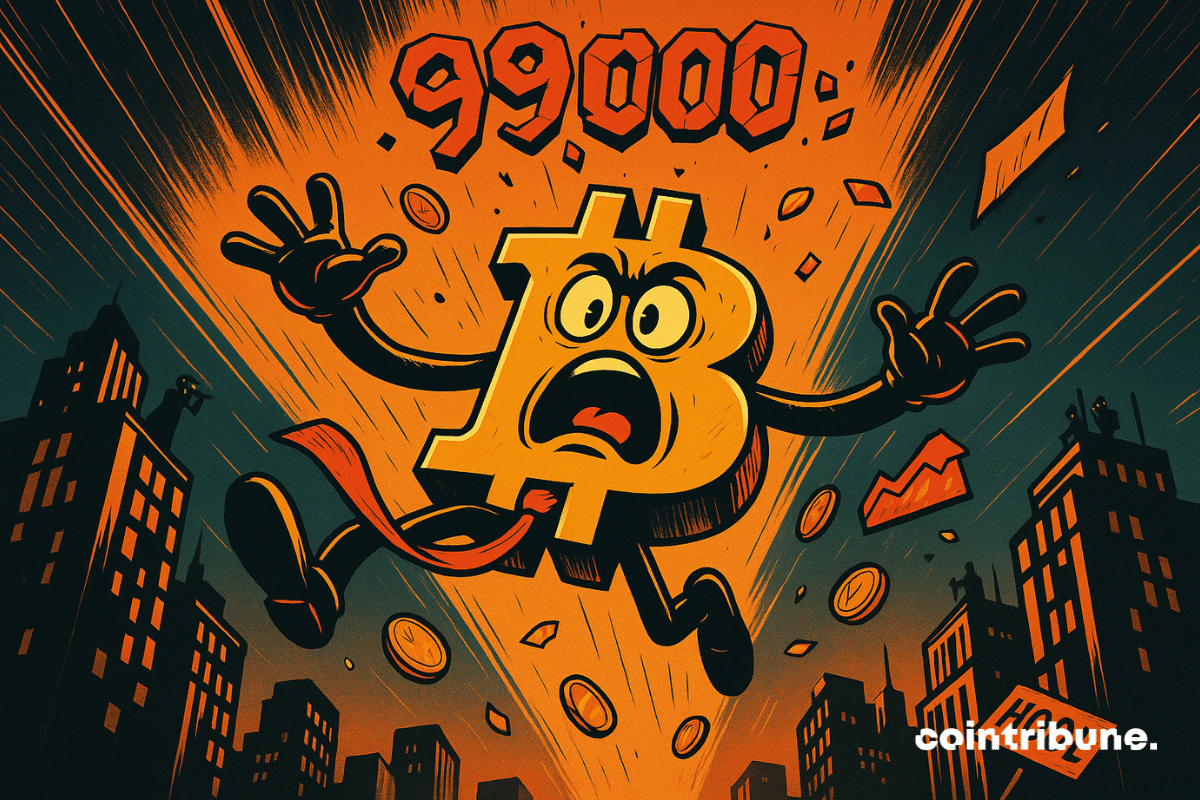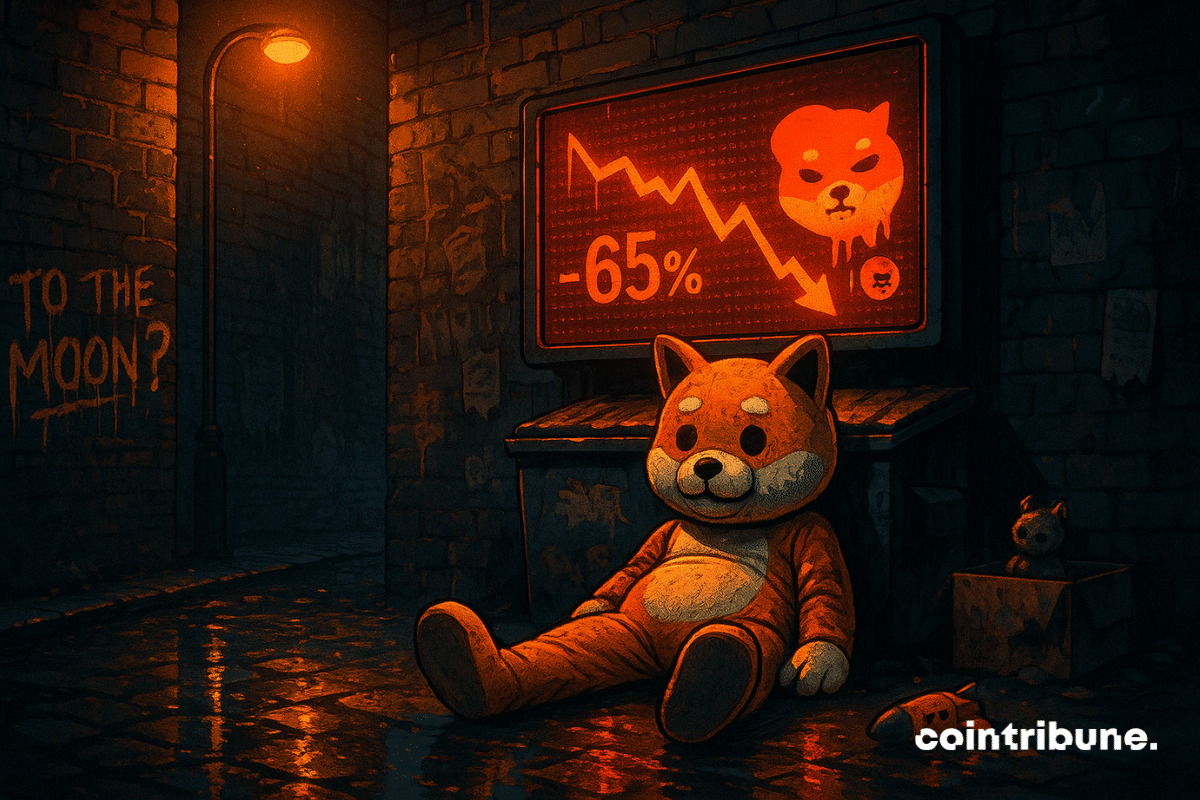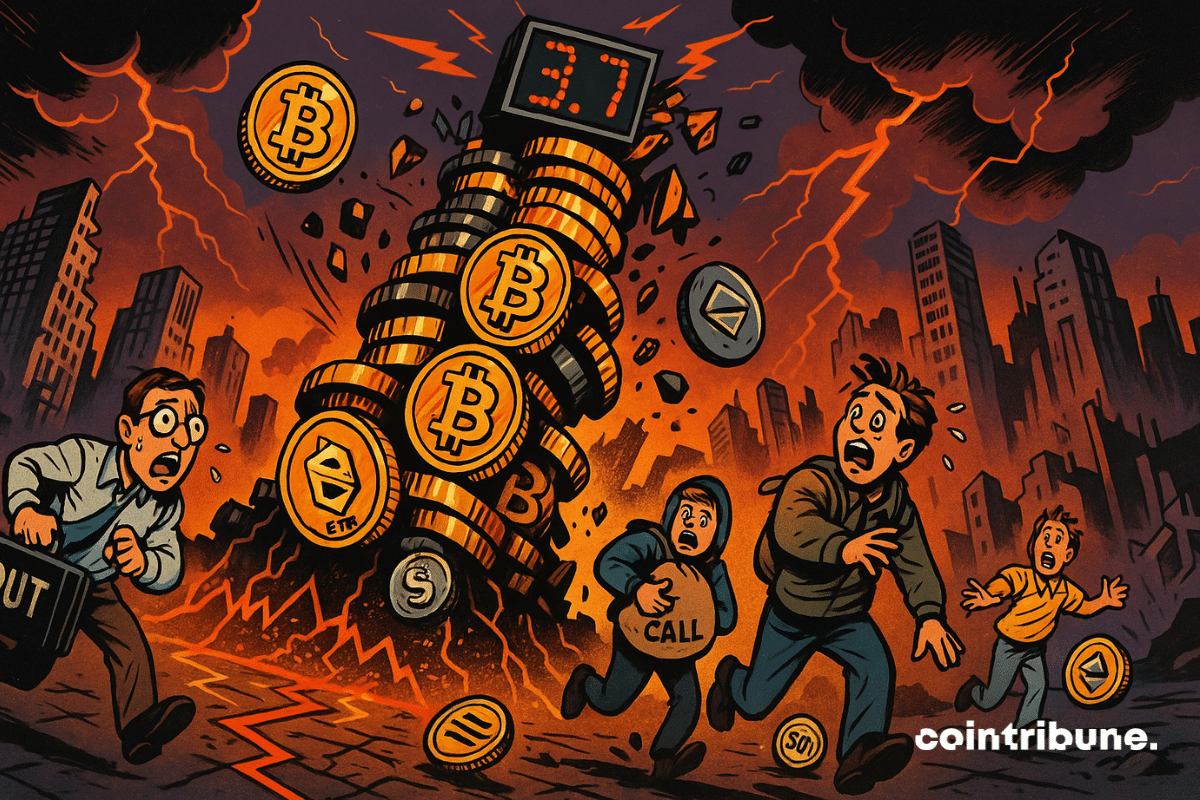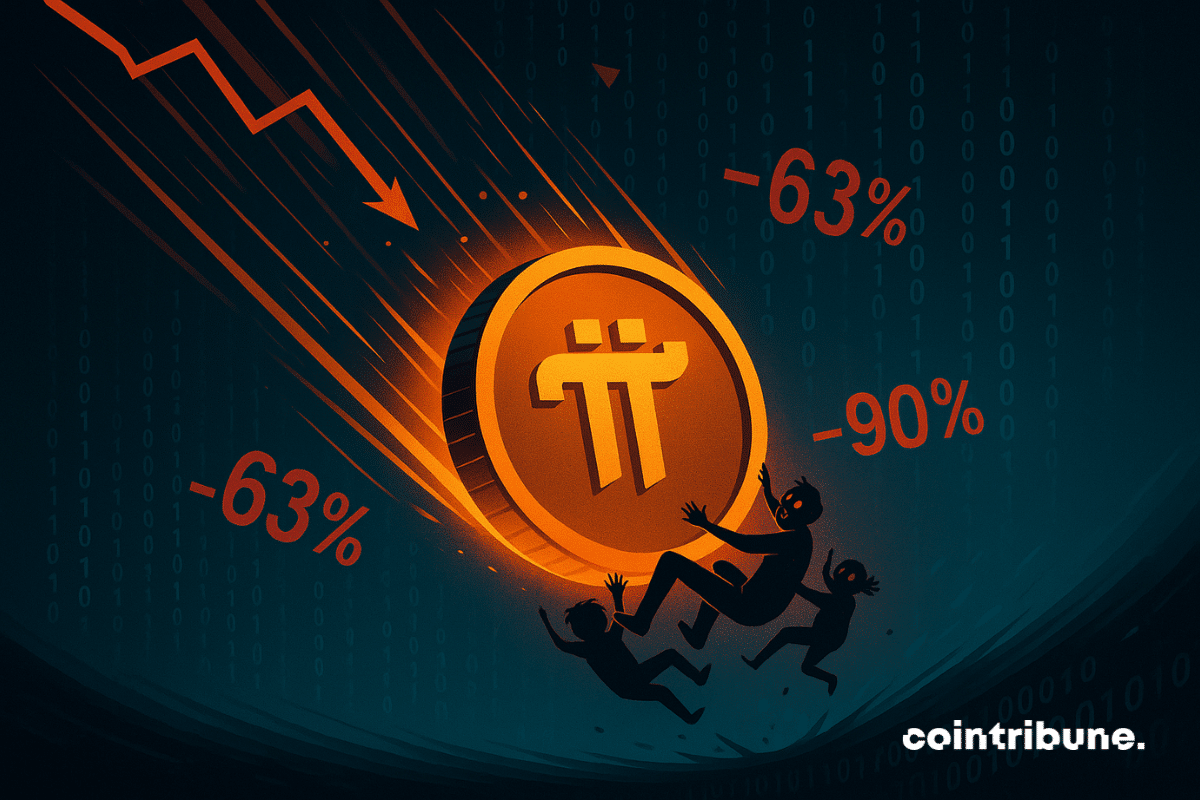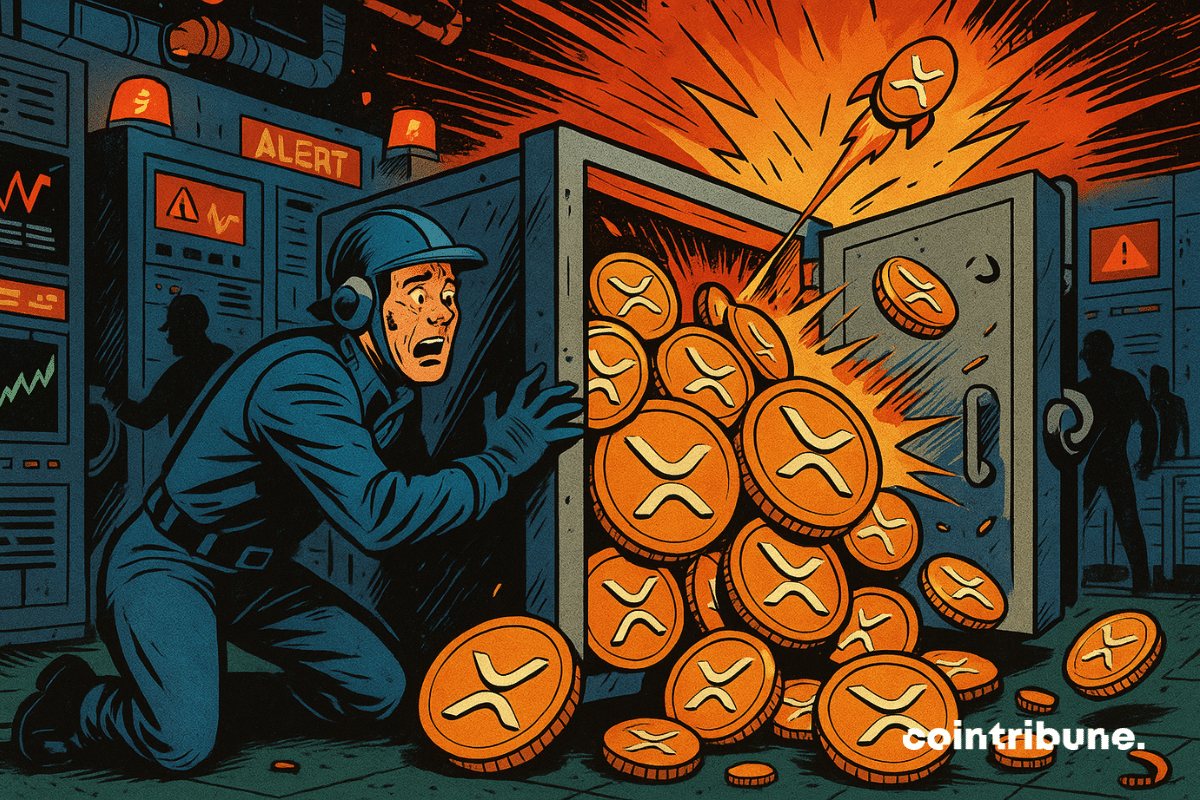As institutional flows reshape its trajectory, Standard Chartered maintains a target of $200,000 for Bitcoin by the end of this year. This forecast is based on a major shift: ETFs and listed companies now dictate the trend. Speculation is giving way to a logic of strategic allocation. Thus, the market is changing hands, tempo, and profile.
Trader
In a market searching for benchmarks, even the slightest regulatory rumor can tip the scales. XRP is a perfect illustration of this: trapped between $2 and $2.35, the asset is drawing increasing attention amidst speculation surrounding an ETF. Far from the usual tumult surrounding bitcoin, this tension places Ripple's crypto at the convergence of a double issue: technical unlocking and institutional recognition.
The crypto market is taking a strategic turn. After a tumultuous June marked by geopolitical tensions and price volatility, July is emerging as an unprecedented window of opportunity. While Bitcoin remains firmly above $100,000, bullish signals are multiplying, supported by the return of institutional flows. In this climate full of expectations, five cryptocurrencies are emerging as must-haves to capture the momentum of the next bull run.
On the occasion of Pi2Day, celebrated every June 28, Pi Network unveiled two strategic features: a no-code application creation tool powered by AI and a community staking mechanism to promote projects. This initiative marks a turning point towards a more accessible platform, governed by its users. By focusing on intelligent automation and the decentralization of referrals, Pi Network aims to redefine the rules of mobile-first Web3, at the intersection of technological innovation and community engagement.
As the crypto market oscillates between regulatory uncertainty and technical expectations, XRP captures the attention of the most strategic investors. For over four months, Ripple's flagship asset has remained stuck between $2.00 and $2.60, in a consolidation that intrigues. This stability, unusual for such an exposed crypto, fuels speculation about a possible breakout.
The Pi Network token jumped 38% this week, fueled by a series of signals interpreted as the beginnings of a partnership with Google AI. In the wake of this momentum, Nicolas Kokkalis's participation in a panel on artificial intelligence at Consensus 2025 and the imminent Pi2Day, scheduled for this Saturday, June 28, are stirring speculation. Although still in transition to its mainnet, the project is capturing attention and fostering hopes for a strategic turning point for its ecosystem.
A simple emoji posted by Arthur Britto, co-founder of Ripple, was enough to reignite speculation about the future of XRP. Having disappeared from the radar for nearly fourteen years, the elusive engineer has broken his silence on X without a word. In an industry where every signal matters, this unexpected reappearance of a key player in Ripple's history raises many questions about his intentions and the role he might play in the ecosystem.
The calm will have been short-lived. Within a few hours, Bitcoin dropped below $99,000, triggering a chain reaction: over a billion dollars in positions liquidated, altcoins shaken up, and volatility reignited. The episode, marked by rare brutality, reminds us of the relentless mechanics of leveraged markets. After several weeks of calm, the correction hits hard, sweeping away the illusion of a controlled recovery. Reckless traders bear the cost of excessive confidence, in a market always quick to flip.
The figure is attention-grabbing: 65% of Shiba Inu (SHIB) holders are currently recording losses. This observation, derived from the latest on-chain data, occurs during a marked correction phase for cryptocurrencies with a strong speculative component. Boosted yesterday by the viral excitement of memecoins, SHIB now reflects the uncertainties of a market where the community is no longer enough to support the price.
Driven by the promise of mining accessible from a smartphone, Pi Network had successfully mobilized a vast community. However, as volumes explode on centralized exchanges and official announcements struggle to convince, the project is going through an unstable period. Now, enthusiasm is giving way to doubts, fueled by opaque decisions and communication deemed disappointing. A strategic turning point seems inevitable, or else one of the most closely followed projects in the crypto sphere may disappear.
In a crypto market still marked by uncertainty, a subtle signal announces a trend reversal. XRP, long in the background, shows a sudden acceleration in its on-chain activity, with a 50% surge in payments in 24 hours. As the crypto stabilizes on a key technical support, some analysts mention the beginnings of a bullish reversal. Away from the limelight, Ripple seems to be awakening market attention.
Despite a sluggish market, Ethereum rekindles interest on two major prediction platforms. Far from institutional analyses, it is thousands of anonymous traders injecting millions of dollars into a bet as bold as it is unexpected: seeing ETH climb to $6,000. This speculative resurgence, fueled by Polymarket and Kalshi, awakens interest around an asset whose trajectory seemed frozen. Behind these bets, a conviction persists: the major movements of Ethereum are not behind, but yet to come.
And what if the greatest store of value of tomorrow was no longer backed by a state, but coded into a protocol? In a world plagued by inflation and soaring sovereign debt, Bitcoin is increasingly establishing itself as a credible alternative to U.S. Treasury bonds. Hunter Horsley, CEO of Bitwise, argues that this transition is no longer a marginal theory, but a fundamental trend driven by growing adoption and disenchantment with traditional safe havens.
A scam involving NFTs is shaking up the world of professional football. In Spain, six high-profile players, including an Argentine world champion and two former stars of FC Barcelona, are the subject of a judicial investigation. Accused of lending their image to a blockchain project resembling fraud, they are said to have helped ensnare thousands of investors. The case, with complex financial ramifications, sheds light on the possible excesses when sporting fame and crypto technologies intertwine without safeguards.
In just a few hours, cryptocurrencies have faltered under the weight of a major geopolitical event. Following Israeli strikes in Iran, over one billion dollars in positions were liquidated, taking with them the market's recent gains. This is not just a simple episode of volatility, but a tangible sign that these assets, which stem from a promise of sovereignty, remain exposed to real-world shocks.
After six years of waiting and millions of accounts created, Pi Network began its transition to the mainnet with the promise of a decentralized cryptocurrency accessible to all. However, as the migration accelerates, an increasing number of users are finding themselves stuck: empty wallets, validated but ignored KYC, failed verifications. What was supposed to mark the culmination of the project is turning into a technical deadlock for many, raising doubts about the reliability of the system and the network's ability to fulfill its commitments.
Violent return to reality for XRP traders. Within 24 hours, a historic imbalance in liquidations triggered instability in the derivatives market, trapping traders. As the crypto plunged below $2.30, the leverage turned against those betting on a continued bullish trend. This technical setback, seemingly innocuous, raises questions about the strength of the narrative surrounding XRP.
The crypto market remains suspended on technical signals that experienced investors scrutinize closely. On XRP, the alert has been raised: a death cross, a bearish crossover of moving averages, has just been detected. Rare and feared, this signal often heralds prolonged pullback phases. In a climate of indecision where the asset struggles to regain a direction, this indicator could modify investors' perceptions and influence their short-term positions. This configuration could weigh heavily on the trajectory of XRP.
In the ruthless world of crypto, some drops leave no room for ambiguity. The Pi Network crypto, which promised public access to mobile mining, now falters under the weight of a challenging market. As its PI token slips towards $0.60, technical indicators turn red and confidence erodes. Where advocates hoped for a rebound, it is a constant selling pressure that prevails, signaling a potentially lasting shift in the project's trajectory.
Nearly 4 billion dollars in options for Bitcoin and Ethereum are set to expire this Friday, June 6, drawing the attention of a pressured market. With predominantly bullish positions and prices below critical thresholds, this expiration could trigger a wave of volatility. In a tense geopolitical climate, traders and institutional investors are proceeding cautiously, aware that even the slightest price movement could reshuffle the deck in the very short term.
In the crypto ecosystem, few announcements redefine the fundamentals. Yet, Cane Island Digital reveals that more than a third of mined bitcoins are permanently lost. Far from being just a statistic, this reality disrupts the understanding of actual supply, increases the asset's scarcity, and questions current valuation models. This silent phenomenon, often overlooked, raises critical issues: how to value an asset whose growing portion is evaporating? And how far could this gradual disappearance reshape the monetary landscape of bitcoin?
Conceived as a decisive step towards account abstraction, the Pectra update is already disrupting the security balances on Ethereum. Introducing the EIP-7702 standard, supported by Vitalik Buterin, it allows wallets to temporarily behave like smart contracts. However, scarcely deployed, this innovation is being hijacked on a large scale to automate attacks. Far from eliminating risks, the evolution of the protocol creates new, more subtle ones that hackers are already rushing to exploit.
When six words and a simple bitcoin graphic are enough to spark excitement, it means Michael Saylor has struck again. The co-founder of Strategy, a leading figure in BTC maximalism, posted a message on X that is as short as it is eloquent: "orange is my favorite color." Behind this wink lies a new strategic purchase operation, in a climate where his company continues to acquire bitcoin. An enigmatic statement, but unequivocal for insiders.
In a few days, the euphoria has evaporated from the crypto market, giving way to a cold caution. While Bitcoin fell after peaking at around $112,000, the Crypto Fear and Greed Index abruptly shifted from "extreme greed" to neutrality. Set at 50, this score indicates a clear psychological turning point among investors. This dual inflection, between technical pullback and emotional disenchantment, reflects a major strategic turning point in the market dynamics.
When a project touted for its mass adoption collapses under market pressure, the signal is strong. The PI token of Pi Network dropped by 22%, reaching $0.61 on May 31, 2025. This decline comes as the overall crypto market has seen more than $170 billion evaporate in a week. The magnitude of the downturn now raises questions about the project's viability and the confidence that its historical investors can still place in it.
As bitcoin confidently crossed the $105,000 mark, a significant pullback has disrupted this momentum, raising doubts among investors. However, far from a collapse, several technical indicators suggest a controlled consolidation. In an ecosystem where volatility is the norm, this retracement phase reveals a subtle tension between speculation and structural strength. More than just a simple fluctuation, the current situation illustrates the precarious yet strategic balance that the market is trying to maintain, at the crossroads of bullish signals and necessary phases of breathing.
The crypto market has just dramatically reminded us of its unpredictability. In 24 hours, over 827 million dollars in positions were liquidated, hitting bullish bets hard as Bitcoin, Dogecoin, and other cryptos plunged sharply. This rout occurs in a tense global context, mixing economic uncertainties and geopolitical tensions. While the euphoria of a bull run seemed to take hold, the reality of the market swept away the most firmly anchored hopes.
In a crypto ecosystem where every move is scrutinized by investors, the sudden rise of XRP on the regulatory scene is intriguing. In just a few days, the likelihood of approval for a spot ETF backed by this asset has jumped to 83%, according to Polymarket. This figure, far from trivial, crystallizes a strategic turning point in the battle between the crypto industry and the SEC. More than just a speculative signal, it embodies a possible shift towards long-awaited institutional legitimization.
While Bitcoin breaches a new peak of over $111,000, XRP is navigating a climate of uncertainty. Driven by the accumulation of tokens by large holders, Ripple's cryptocurrency is experiencing a bullish momentum. However, this dynamic is accompanied by tensions: the rapid increase in reserves on Binance and other exchanges fuels doubts. In an ultra-reactive market, where every indicator matters, this unstable configuration calls for a nuanced reading of the dynamics at play.
Bitcoin has reached a new historic high of over $111,000, but without the usual tumult of an excited market. On May 22, 2025, the ascent of the queen of crypto took place in a puzzling calm, far from past speculative eruptions. Such a divergence between price performance and market restraint intrigues analysts. Some see it as the beginnings of a regime change: a more mature dynamic, supported by solid fundamentals rather than irrational exuberance.

